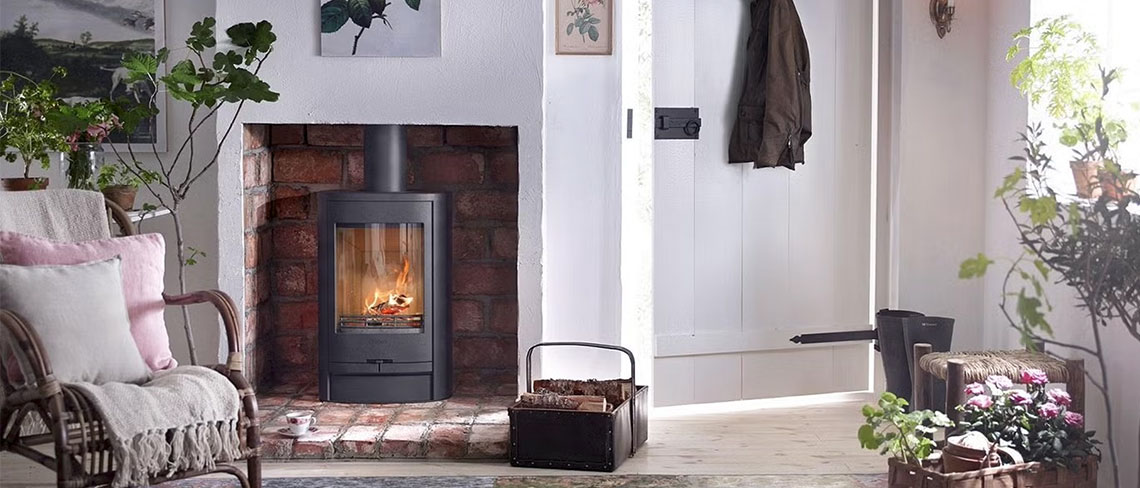
Scandi interiors expert shares tips for embracing eco-friendly interior design for a happier home and planet.
As we head into ‘cosy’ season, many of us might be thinking about making adjustments to our interiors to create a sanctuary that will see us through the colder, darker months. For those who are thinking about upgrading or renovating the home this autumn/winter, it’s important to ensure you do so sustainably, for the long-term benefit of your home, its inhabitants and the planet.
Catharina Björkman, Scandi interiors expert at Contura, says, “Scandinavian design tends to prioritise longevity, simplicity, and sustainability over any desire to keep up with the latest interior trends or newest must-have items.
“Such priorities are reflective of wider Scandinavian philosophies such as lagom, a concept rooted in the belief that balance and moderation are central to happiness, and friluftsliv, which emphasises the importance (and benefits) of spending time in nature.
“It is therefore unsurprising that Scandinavian homes often feature natural, minimalist, and timeless interiors, with the belief that all such elements will help to foster a happy, peaceful environment, perfect for the home – which should act as a haven.”
Read on for Catharina’s guide to embracing sustainable Scandi design in your home this autumn/winter…
Back to nature
Choose natural materials to furnish your home; a staple of traditional Scandinavian design. This will have a lasting, positive impact both inside and outside your home.
Be sure to incorporate a variety of textures – smooth, solid, soft, and silky – into each room. Every material holds a different visual weight and depth and so, when combined mindfully, create a beautifully balanced, harmonious, and intriguing interior.
Wood, bamboo and natural stone are ideal and sustainable choices for incorporating solid, rustic, and smooth surfaces into each room.
Add softer textures using plant fibres and natural fabrics amongst other eco-friendly materials. Think velvety cashmere blankets, light cotton lampshades, fluffy wool rugs, woven jute baskets, seagrass placemats, reed backets, and cork pinboards.
Feel good with wood
Wood is a core ingredient in the recipe of any Scandinavian home. The material helps to create timeless and elegant interiors, though its benefits run far deeper than surface-level aesthetics.
Incorporating wood into interior spaces has been linked to reducing stress , a belief further supported by the Scandinavian philosophy of friluftsliv, which revolves around the idea that increased proximity to nature elevates wellbeing. The capacity to promote relaxation makes wood the perfect material for home interiors.
Wood is also one of the most sustainable materials. Living trees absorb carbon dioxide and are also able to be replanted again and again.
More specifically, hardwood tree varieties – such as ash, chestnut, or oak – produce high-density and, consequently, extremely durable wood, an ideal material to use for larger surfaces and objects, such as flooring, wardrobes, and shelves. The long lifespan and low maintenance nature of hardwood make it well-worth the investment.
Mindful homemaking
When it comes to decking out your home, take a mindful approach. Famed for their minimalism, Scandinavians tend to prefer filling their home with long-lasting, high-quality, and much-treasured possessions rather than being tempted by the modern-day habit of constantly bringing in the new and throwing out the old.
Always ask yourself whether this new item is something you really want or need. A great way to gauge this is with the test of memory and time. Write down any desired items on a wish list, pop this away for a week or so, and, upon returning to it, ask yourself: can you remember all the items and, if so, do you still feel strongly about having them? This will help to avoid any impulse purchases, which can often end up sitting unused and unappreciated after the initial excitement fades.
Where possible, look to source any new household items second-hand. Your local charity shop, flea market or online marketplace can be great spots to find vintage gems. This approach is more environmentally friendly and can often result in finding high-quality, timeless items for a significantly lower price than their shiny, new counterparts.
Reconsider, revamp and recycle
Natural wear and tear can mean that some objects lose their original function or beauty, but if this happens, do not give in to your first impulse to throw it away.
Firstly, consider whether you might be able to give the item a new lease of life with a makeover. You would be amazed how a light touch of handiwork, be it a thorough clean, a fresh lick of paint, or a quick sanding session, can transform an item to look better than new.
If this is not an option, explore the possibility of upcycling – the process of taking old, unused objects and repurposing them for use in new, wonderful ways. Think empty jars transformed into small flower vases, old clothes acting as new cleaning rags, used tins being useful pen pots, and glass bottles becoming stylish candle holders.
You may feel that some belongings, even if revamped or repurposed, are simply no longer of use to you, contributing to physical (and mental!) clutter. Look to donate any unwanted items to charity shops, pass them on to friends, or sell them online – after all, as the saying goes, one person’s trash might be another person’s treasure!
Peaceful palettes
Colour can play a key role in influencing mood, so it is important to be mindful of which colour schemes you decide to use when it comes to your interiors. Soft, earthy, and neutral palettes are perfect for the home, all being linked to fostering feelings of calm.
Opt for darker shades – like warm taupe, sandy yellows, and earthy pinks – in places where you are likely to want to feel cosy and comfortable, such as the living room. Incorporate lighter, neutral colours – think milky whites, gentle greys, and light browns – into spaces more suited to feeling fresh and productive, for example, the kitchen.
For those looking to add a little more colour to their interiors (whilst maintaining this important sense of serenity), continue to take inspiration from the softer hues of nature, such as sky blues, pistachio greens, primrose yellows, and sunset oranges.
Of course, there is no need to shy away from bright colours entirely – after all, everyone is different and it is important that your home is reflective of you. A great way to incorporate some of your favourite colours into your interiors – whether they be cobalt blue, scarlet red, or electric pink – is by adding small, uplifting bursts throughout, for example, with a fun plant pot on the bathroom windowsill or groovy pillow in your bedroom.
Embrace the elements
When it comes to designing and decorating your home, be sure to work with nature rather than fighting against it.
Make the most of the natural light by keeping window spaces clear, so as not to block any rays. Position desks, dining tables, and any other freestanding furniture, likely to dictate where you’ll spend prolonged periods of time, in sunspots so that you can make the most of the (sometimes rare!) UK sunshine.
In north-facing rooms, subtlety decorate using resources and objects which will add light-reflecting surfaces – white paints, mirrors, and metallic surfaces – to make most of the light available.
Finally, when it comes to heating your home, a woodburning stove is an ideal option and, with the ongoing surge in gas prices, has the added bonus of providing a cost-effective alternative. Wood has long-been an energy source for humans, with the flickering light and toasty warmth of a fire providing both warmth and comfort for generations.
Contrary to popular belief, woodburning stoves can offer an efficient, sustainable, and cost-effective heat source, releasing up to 90% less emissions compared to a traditional open fire for example, and using only wood – a renewable, low-carbon energy source.
For more information, please visit www.contura.eu.
-Ends-
Notes to editors:
- Rooster PR will coordinate comment, interview and profile opportunities for Contura UK Country Manager, Phil Wood.
- The Contura PR team will also arrange visits to the nearest Contura Design Centre dealerships or the Contura showroom in Doncaster to see the product range.
For further press information, please contact:
Tilly Everard | Anna Nyman | Elsa Findlay | Julie Aguilera
Rooster.
T: +44 (0)203 440 8930
E: [email protected]
About Contura:
Contura is Europe’s leading manufacturer of wood burning stoves, offering an extensive range of classic and contemporary wood burners; from traditional insert stoves suitable for existing fireplaces, to freestanding statement models made with innovative materials such as soapstone.
Starting at £1,495, Contura stoves are premium yet affordable. Award winning, timeless Swedish design means the products complement or enhance any style of home, whilst also offering outstanding performance, maximum efficiency, practicality and ease of use.
Designed and assembled at the factory located in Markaryd, Sweden, and manufactured to the highest standards, Contura stoves are highly energy efficient, offering powerful convection, superior combustion technology and clean burning systems. All Contura stoves are DEFRA Clean Air Act exempt and thus approved for use in Smoke Control Areas.
Contura stoves can be purchased through a network of 165 independent retailers nationwide.
Contura is part of the NIBE group, a Swedish manufacturing company producing world class solutions in sustainable energy across Europe, North America, Asia and Australia.
Contura is a founding member of the Stove Industry Alliance (SIA) in the UK.
For more information please visit www.contura.eu






